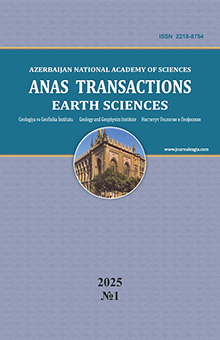№ 2,
2021
Modeling of modern Earth surface movements along the east coast of the Caspian Sea by GPS data
Baku State University 23, akad. Z.Khalilov str., Baku, AZ1148
Summary
A-
A+
The results of GPS monitoring in Azerbaijan show that the studied area is characterized by different geodynamic regimes. The fact that the components of the VE velocity vectors of several GPS points relative to the east of the West Caspian fault have higher values than the VN components shows that the velocity vectors observed at these points are sharply rotated to NNE. The purpose of this paper is to investigate the relationship between velocities at these GPS stations and the kinematics of the South Caspian Basin. A kinematic model was chosen to determine the theoretical values of the GPS point vectors. Along with this, the South Caspian depression and the Iranian plate were considered as regional tectonic elements in the formation of deformation structures. The study area is bounded to the north by the Central Caspian seismic zone and to the west by the West Caspian fault. The velocities obtained from model calculations using the Okada formula agree with the measured ones. The Lower Kur, Gobustan and Absheron structural regions east of the South Caspian fault move clockwise along with the South Caspian block, which is exposed to pressure from the Iranian plate. It has been established that the GPS velocities of the structural sections of the Lower Kur, Gobustan and Absheron are caused by the movement of the South Caspian basin, which rotates clockwise under the effect of the Iranian plate.
Keywords: GPS monitoring, components of the VE and VN velocity vectors, South Caspian Basin, kinematic model
REFERENCES
Alizadeh A.A., Guliyev İ.S., Kadirov F.A., Eppelbaum L.V. Geosciences of Azerbaijan. Economic Geology and Applied Geophysics – Springer International Publishing. 2017, pp. 340.
Allen M., Jackson J., Walker R. Late Cenozoic reorganization of the Arabia-Eurasia collision and the comparison of short-term and long-term deformation rates. Tectonics, Vol. 23, TC2008, 2004, DOI:10.1029/2003TC001530.
Djamour Y., Vernant P., Bayer R., Nankali H.R., Ritz J.F., Hin-derer J., Hatam Y., Luck B., Lemoigne N., Sedighi M., Khorrami F. GPS and gravityconstraints on continental de-formation in the Alborz mountain range. Iran. Geophys. J. Int., Vol.183, 2010, pp. 1287-1301.
Jackson J. Partitioning of strike-slip and convergent motion between Eurasia and Arabia in eastern Turkey. J. Geophys. Res., Vol. 97, No. B9, 1992, pp. 12471-12479.
Kadirov F., Floyd M., Alizadeh Ak., Guliev I., Reilinger R., Ku-leli S., King R., Toksoz M.N. Kinematics of the eastern Caucasus near Baku, Azerbaijan. J. Natural Hazards, vol. 63, No. 2, 2012, pp. 997-1006, DOI 10.1007/s11069-012-0199-0.
Kadirov F., Mammadov S., Reilinger R., McClusky S. Some new data on modern tectonic deformation and active faulting in Azerbaijan (according to Global Positioning System measurements). Proceedings of Azerbaijan National Academy of Sciences, The Sciences of Earth, No. 1, 2008, pp. 82-88.
Kadirov F.A., Floyd M., Reilinger R., Alizadeh Ak.A., Guliyev I.S., Mammadov S.G., Safarov R. Active geodynamics of the Caucasus region: implications for earthquake hazards in Azerbaijan. Proceedings of Azerbaijan National Academy of Sciences, The Sciences of Earth, No. 3, 2015, pp. 3-17.
McCaffrey R. TDEFNODE User’s manual version. 2020, https: //robmccaffrey.github.io/TDEFNODE/manual/tdefnode_manual.html.
McKenzie D.P. Active tectonics of the Mediterranean region. Geophys. J. R. Asron. Soc., Vol. 30, 1972, pp. 239-243.
McQuarrie N., Stock J.M., Verdel C., Wernicke B.P. Cenozoic evolution of Neotethys and implications for the causes of plate motions. Geophys. Res. Lett., Vol. 30, No. 20, 2003, pp. 2036, DOI:10.1029/2003GL017992.
Mousavi Z., Walpersdorf A., Walker R.T., Tavakoli F., Pathier E., Nankali H., Nilfouroushan F., Djamour Y. Global Positioning System constraints on the active tectonics of NE Iran and the South Caspian region. Earth and Planetary Science Letters, Vol. 377-378, 2013, pp. 287-298.
Okada Y. Internal deformation due to shear and tensile faults in a half-space. Bull. Seismol. Soc. Am., Vol. 82, 1992, pp. 1018-1040.
Philip H., Cisternas A., Gviskiani A., Gorshkov A. The Caucasus: An actual example of the initial stages of continental collision. Tectonophysics, Vol. 161, 1989, pp. 1-21.
Reilinger R. and 22 others, GPS constraints on continental deformation in the Africa-Arabia-Eurasia continental collision zone and implications for the dynamics of plate interactions. J. Geophys. Res., Vol. BO5411, 2006, doi:10.1029/2005JB0 04051.
Robertson A.H.F. Mesozoic-Tertiary tectonic evolution of a south Tethyan ocean basin and its margins in southern Turkey. In: Tectonics and magmatism in Turkey and the surrounding area, (Bozkurt E., Winchester J.A. and Piper J.D.A., eds.), Geol. Soc. Spec. Pub., 173, London, 2000, pp. 97-138.
Sengor A.M.C., Gorur N., Saroglu F. Strike-slip faulting and related basin formation in zones of tectonic escape: Turkey as a case study. In: Strike-slip faulting and basin formation (Biddle, K.T. and Christie-Blick N., eds.), Society of Econ. Paleont. Min. Sec. Pub., Vol. 37, 1985, pp. 227-264.
Strang G. and Borre K. Linear algebra, geodesy, and GPS. Wellesley-Cambridge Press. 1997, 642 p.
